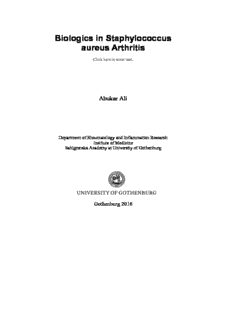
Biologics in Staphylococcus aureus Arthritis PDF
Preview Biologics in Staphylococcus aureus Arthritis
Biologics in Staphylococcus aureus Arthritis Click here to enter text. Abukar Ali Department of Rheumatology and Inflammation Research Institute of Medicine Sahlgrenska Academy at University of Gothenburg Gothenburg 2016 Cover illustration: Micro-CT image of a healthy mouse wrist joint vs. a wrist joint with S. aureus septic arthritis. Biologics in Staphylococcus aureus Arthritis © Abukar Ali 2016 [email protected] ISBN: 978-91-628-9774-1 (print), 978-91-628-9775-8 (electronic) http://hdl.handle.net/2077/41545 Printed in Gothenburg, Sweden 2016 Ineko AB, Göteborg To my family Biologics in Staphylococcus aureus Arthritis Abukar Ali Department of Rheumatology and Inflammation Research Institute of Medicine Sahlgrenska Academy at University of Gothenburg ABSTRACT The emergence of new type of drugs known as biologics has led to rapid disease improvements in many autoimmune arthritic patients. Nevertheless, most of these biologics are immunomodulators that may consequently increase the susceptibility of patients towards infections, such as septic arthritis. Septic arthritis is still considered a major public health challenge due to its rapidly progressive disease character with poor prognosis regarding joint functions. It is mainly caused by Staphylococcus aureus and despite optimal antibiotic treatment, nearly half of patients have permanent joint dysfunction. The main aim of this thesis was to investigate the inflammatory response of the host to living as well as antibiotics-killed S. aureus and to study the effect of biologics on the course of staphylococcal infections. The role of host inflammatory response on post-infectious joint dysfunction using antibiotic- killed S. aureus was the subject of Paper I of this thesis. The main focus of Paper II and III were to study the effects of different biologics treatments on S. aureus induced septic arthritis and sepsis. We demonstrated that antibiotic-killed S. aureus is capable of inducing and maintaining destructive arthritis. By using different knockout mice, we showed that this type of arthritis was mediated through TLR-2, TNFR1 and RAGE receptors. Furthermore, we found that insoluble cell debris was a key initiator of this type of arthritis. Finally, anti-TNF therapy attenuated the arthritis caused by antibiotic-killed S. aureus. All the biologic treatments tested (including anti-TNF therapy, CTLA4-Ig and IL-1 Ra) aggravated S. aureus infections but had different clinical manifestations. Both CTLA4-Ig and IL-1 Ra therapy significantly increased the susceptibility to S. aureus induced septic arthritis in mice. Anti-TNF therapy on the other hand resulted in more severe weight loss and impaired the bacterial clearance ability of the host. In conclusion, antibiotic-killed S. aureus induced chronic destructive arthritis and anti-TNF therapy attenuated this type of joint inflammation. In the living S. aureus induced septic arthritis, all tested biologics complicated the disease course. Therefore, the potential dangers associated with biologics should be taken into account and patients with high risk of S. aureus bacteremia might be considered to refrain from them. Keywords: Staphylococcus aureus; CTLA4-Ig; IL-1 Ra; anti-TNF therapy; mouse; septic arthritis ISBN: 978-91-628-9774-1 (print), 978-91-628-9775-8 (electronic) SAMMANFATTNING PÅ SVENSKA Människokroppen exponeras ständigt för olika former av mikroorganismer. En del av dessa kan vara skadliga för oss om de lyckas ta sig in i kroppen. Lyckligtvis har vi ett immunsystem som konstant är på sin vakt och fungerar som kroppens försvarssystem mot dessa mikroorganismer. Immunförsvarets viktigaste uppgift är nämligen att skydda oss mot att bakterier, virus och parasiter angriper kroppen och orsakar infektioner. Dessvärre kan dock immunförsvaret bli överaktivt och kan då angripa kroppens egen vävnad, vilket orsakar inflammation och vävnadsskada. Personer med ett nedsatt immunförsvar tenderar till att lättare drabbas av infektioner av svårare karaktär. En sådan infektionssjukdom är sjukdomen septisk artrit, även känd som infektiös artrit. Septisk artrit är en ledsjukdom som främst orsakas av den gram-positiva bakterien Staphylococcus aureus. Septisk artrit betraktas som en av de farligaste ledsjukdomarna i dagsläget, då sjukdomen karaktäriseras av att den snabbt förvärrar patientens hälsotillstånd. Trots optimal antibiotikabehandling ger septisk artrit upphov till permanenta skador i lederna hos uppemot 50 % av patienterna. Utvecklandet av en ny grupp av läkemedel, så kallade biologiska läkemedel, har bidragit till en väsentlig förbättring bland många patienter som lider av autoimmuna artritsjukdomar. Denna läkemedelsgrupp dämpar dock immunsystemet och ökar risken för utveckling av infektioner. Risken att drabbas av en specifik infektion, t.ex. septisk artrit, har däremot inte studerats väl. I denna avhandling har jag studerat möjliga orsaker till permanenta ledskador vid septisk artrit i en musmodell. Vidare har jag också studerat olika biologiska läkemedel och deras inverkan på stafylokock-inducerad septisk artrit och sepsis. Sammantaget visar denna avhandling att ett alltför aktivt immunförsvar orsakat av antibiotika-avdödade stafylokocker kan ge upphov till bestående ledinflammation och skador. Jag har också kunnat påvisa att olika biologiska läkemedel, som används mot reumatoid artrit, kraftigt ökar risken för stafylokockinfektioner. LIST OF PAPERS This thesis is based on the following studies, referred to in the text by their Roman numerals. I. Ali A, Zhu X, Kwiecinski J, Gjertsson I, Lindholm C, Iwakura Y, Wang X, Lycke N, Josefsson E, Pullerits R, Jin T. Antibiotic-killed Staphylococcus aureus induces destructive arthritis in mice. Arthritis Rheumatol, 2015; 67:107-116. II. Ali A, Welin A, Schwarze JC, Svensson MN, Na M, Jarneborn A, Magnusson M, Mohammad M, Kwiecinski J, Josefsson E, Bylund J, Pullerits R, Jin T. CTLA4 Immunoglobulin but Not Anti-Tumor Necrosis Factor Therapy Promotes Staphylococcal Septic Arthritis in Mice. J Infect Dis, 2015; 212: 1308-1316. III. Ali A, Na M, Svensson MN, Magnusson M, Welin A, Schwarze JC, Mohammad M, Josefsson E, Pullerits R, Jin T. IL-1 Receptor Antagonist Treatment Aggravates Staphylococcal Septic Arthritis and Sepsis in Mice. PLoS One, 2015; 10(7) i OTHER PUBLICATIONS Other publications not included in this thesis: Na M, Jarneborn A, Ali A, Welin A, Magnusson M, Stokowska A, Pekna M, Jin T. Deficiency of the complement component 3 but not factor B aggravates Staphylococcus aureus septic arthritis in mice. Infect Immun, 2016. Nowrouzian FL, Ali A, Badiou C, Dauwalder O, Lina G, Josefsson E. Impacts of enterotoxin gene cluster-encoded superantigens on local and systemic experimental Staphylococcus aureus infections. Eur J Clin Microbiol Infect Dis, 2015; 34:1443-1449. ii
Description: